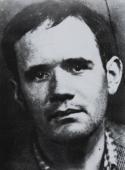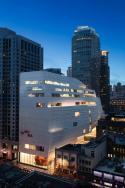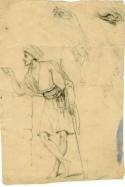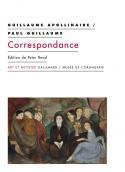Art Of The Day Weekly
#430 - from 12 May 2016 to 18 May 2016
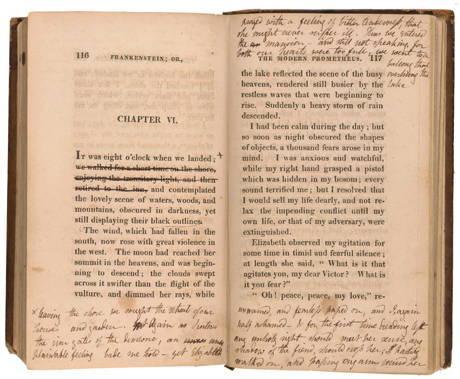
Mary Shelley, Frankenstein, or, The Modern Prometheus, London, Lackington, Hughes, Harding, Mavor, and Jones, 1818, 3 volumes. Original edition belonging to the author, Pierpont Morgan Library, New York (exhibition Fondation Bodmer, Geneva).
IN THE AIR
Frankenstein is back in Switzerland
GENEVA – Was Frankenstein a Swiss citizen? There is some truth in this since it was in Cologny, in the fashionable suburb of Geneva, that Mary Shelley (1797-1851) wrote her famous book in 1816. It was during a stay at the villa Diodati, rented by Byron for the young English colony. Two hundred years later, the precious manuscript, the property of the Bodleian Library in Oxford, is back on the shores of lake Léman. Together with other major pieces, such as the first edition from 1818, with notes by the author (on loan from New York), portraits of Mary and of her husband, poet Percy Bysshe Shelley who died at age 29 (from the National Portrait Gallery), the exhibition traces the unique destiny of this story, the fruit of the imagination of a young woman who was not yet 19 years old.
• Frankenstein, créé des ténèbres at the Fondation Bodmer, from 13 May to 9 October 2016.
EXHIBITIONS
Genet unsubordinated
MARSEILLE – For a long time he was among the losers, the banished. A bastard child, brought up by peasants in the French Morvan region, Jean Genet was averse to all type of authority and consequently often found himself in prison. For repeated thefts –a material sample at the magasins du Louvre, bottles of alcohol, books from the Gibert bookstore -, he incurred life imprisonment! Cocteau intervened courageously to defend his protégé whom he saw as the most promising writer in France. He saved him and set him definitely on the track of literature. This in no way limited his taste for provocation, for scandal, nor the defense of the oppressed. The exhibition tells us of this surprising destiny by putting side by side drawings – in particular two portraits by Giacometti, a good friend -, videos – a surprising television interview of Jean-Louis Barrault by Michel Droit after the riot at the Odéon theater in Paris for Les Paravents in 1966 – and a series of manuscripts. There is the Journal du voleur as well as a letter to Gide in which young Genet writes about his trip to Tripolitaine. His magnificent style, the richness of his writing and his perfect grammar leave us all speechless, given how they contrast with the stereotype image of an illiterate convict.
• Jean Genet, l’échappée belle at the Mucem, from 15 April to 18 July 2016.
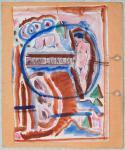
Water colour frontispice of Éden, Éden, Éden (published in 1970 by Éditions Gallimard) Fonds Pierre Guyotat (NAF 28094) from the Bibliothèque nationale de France.
Guyotat the rebel
PARIS – Similar to Genet’s work, that of Pierre Guyotat was also violently contested, accused of being obscene or incomprehensible. Following a path that is as bumpy as that of his elder, the author had his wanderings, underwent disciplinary measures during his military service, was arrested, caused remarkable scandals (in particular for his Eden, Eden, Eden in 1970), and slowly but surely he has become a classic in his own way. The exhibition presents a part of his manuscripts and his drawings and orchestrates a dialogue with certain artists he has affected, from Miquel Barceló to photographer Eric Rondepierre.
• Pierre Guyotat, la matière de nos œuvres at the galerie Azzedine Alaïa, from 22 April to 12 June 2016.
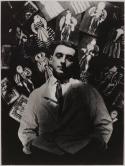
Jean Hugo facing his drawings for costumes and decors for Romeo and Juliette, anonymous photographer, 1924.
Hugo & Co.
PARIS – The Hugo family lives on, the names change. It is quite a game to follow the descendants of the great Victor. We learn he transmitted the bug of creation to his descendants. Next to his own works – now famous pen drawings and water colours– here we have the production of other Hugos: his son François-Victor, the translator of Shakespeare but also a Daguerreotypist, his nephew Léopold, an eccentric mathematician who drew strange universes, his grandson Georges, who drew the trenches during World War I, his great-grandson Jean (1894-1984), a stage designer in Paris during the roaring twenties. Including the current representatives of the fifth generation,painter Marie and photographer Jean-Baptiste.
• Les Hugo, une famille d’artistes at la Maison de Victor Hugo, from 14 April to 18 September 2016.
MUSEUMS
Art power
SAN FRANCISCO – Founded in 1935, the SFMOMA (San Francisco Museum of modern Art) was first housed in the Veterans Building where the Charter of the United Nations was signed in 1945, before moving in 1995 to a building designed by Mario Botta. On 14 May it will unveil the extension that will allow it to triple its exhibition space. The new area was designed by the Norwegian firm Snöhetta (the one that designed the library of Alexandria, the opera house in Oslo and the future museum of Lascaux 4), and it looks like a monolithic, immaculate and ill-squared sandstone bloc, inspired from the fog and lights of the bay. In this new cocoon, obviously of high environmental quality (the composite material of the façade was manufactured less than 50 kilometres down the road), the 33 000 works of the foundation will be looked at in all comfort, in particular the Fisher collection, one of the wealthiest in post-war art. The museum is used to mind-blowing events, having started since 1936 when it was the first to present works by Matisse on the West coast. To keep in tradition, it will take off with 19 inaugural exhibitions. And it will include, with the new Pritzker Center, the largest photography exhibition space in the U.S.A.
• The SFMOMA will reopen to the public on 14 May 2016.
AUCTIONS
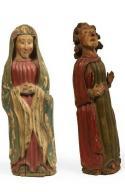
Lot 307, Virgin and Saint John at sculpted and polychrome oak calvary, popular art, XVI-XVIIth centuries, 77 cm and 76 cm. Estimate: €1200-1500.
At home with Audiard
PARIS - Michel Audiard (1920-1985) was one of the most brilliant scenario writers in French cinema. We owe him, among other jewels, Un singe en hiver, Les Tontons flingueurs, Le cave se rebiffe. His dialogues have become matter for a cult and he has a circle of admirers who will undoubtedly throw themselves on the lots of this auction as if they were relics. There is nothing remarkable, except maybe for the beautiful editions of Proust (in 13 volumes published by Gallimard, 1927, estimated at €20 000) or of Céline. But there is a series of objects that accompanied him in his daily life, such as the chair he sat on near the fireplace or the community table on which he worked, to his desk lamp in green opal, including the grey marble mortar from the Pyrénées. Unless the bids should rocket, one could take home his paperweight, his pipe or his kaki coloured cap for just a few hundred euros.
• Vente Audiard 12 and 13 May 2016 at Richelieu-Drouot (Pierre Bergé & associés).
A scent of Champollion
PARIS – This auction, slipped in between the one of the autographs of the members of the French Academie and the correspondence of the very powerful Comité des forges in the 1860s, presents a real little treasure: the manuscripts of Nestor L’Hôte, accompanied at time by pen drawings or water colours (tombs, sites in Nubie, the columns of Karnak, temples of Luxor, etc.). The man - hardly known by the public at large - accompanied Champollion during his second trip to Egypt in 1828, and noted down every adventure (in particular the details of their daily life) and drew for the famous Egyptologist. They both died very young (Champollion in 1832 at age 41, L’Hôte in 1842 at age 38). The nearly forty lots (letters, travel logs, comments for the Musée des antiquités égyptiennes and a 600-page essay on the obelisks!) bring back to life this tempestuous friendship and bids could easily fly past the estimates (between €300 and €10 000).
• Livres et manuscrits 13 May 2016 at Richelieu-Drouot (Tessier & Sarrou).
BOOKS
World libraries
If we believe the prognosis, printed books are definitely on their way out. Yet there have never been as many, and as this surprising selection of libraries throughout the world shows, never before had they been circulated in a more original manner. From the discreet comfort of luxury venues such as The Library Hotel in New York, where the six floors furnished in books are inspired from Dewey’s decimal classification, to the Biblioburro in Colombia, the library carried on a donkey’s back, the ingenuity of librarians, true cultural go-betweens, is rejoicing. In trees as in Norway,in hamacs as in Burundi or in abandoned phone booths like in England, in junks like in Bangladesh, on elephants like in Laos, on camels like in the Gobi desert or on sidewalks like in Manila, in university glass and metal frames like in Aberdeen or on the beach like in Sydney: it seems book loaning has never been so popular. All these very diverse situations remind us that libraries bring together two qualities that seem a priori incompatible, the unpunished vice of reading and the pleasure of transmitting.
• Bibliothèques insolites, by Alex Johnson, published by Jonglez, 2016, 240 p., €19.90
When Guillaume (Apollinaire) spoke to (Paul) Guillaume
One could never exaggerate the importance of Apollinaire (1880-1918) in the genesis of avant-garde movements. He was the friend of Picasso, of Derain, of Chirico, of Douanier Rousseau, among others, and a little more than that in regard to Marie Laurencin! As is confirmed in this correspondence, he was also the mentor of a young ambitious mechanic, Paul Guillaume (1891-1934), who rounded out his income by selling African statues and ended up becoming one of the most important art dealers in Paris. The latter advised, oriented and put the former in contact with painters that mattered. He ended up writing on his own, under various pseudonyms, his magazine, Les Arts à Paris. Their relationship wavered when the art dealer forgot to go to the poet’s wedding and stood him up a number of times for lunch. The poet’s last letter, dated 11 October 1918, is explicit: “Your way of behaving with me is worthy of a good-for-nothing (…)”. The poet died a month later and we will never know how this amazing two-some could have evolved.
• Guillaume Apollinaire/Paul Guillaume, Correspondance (1913-1918), directed by Laurence Campa and Peter Read, Gallimard, 192 p., €19.50.
IN BRIEF
AIX-EN-PROVENCE – The SM’ART, the mediterranean contemporary art fair, will be held from 12 to 16 May 2016.
NEW YORK – The sculpture Him by Maurizio Cattelan representing Hitler on his knees, was sold for $17.2 million at Christie’s on 8 May 2016.
WORLD - Museums and cultural landscapes is the theme of International Museum Day, under the patronage of the ICOM, on and around 18 May 2016.
OPENINGS OF THE WEEK

TONY SOULIÉ
12 mai 2016 - PARIS - Galerie gilbert Dufois
A coloured visual universe, fed by a score of travels

